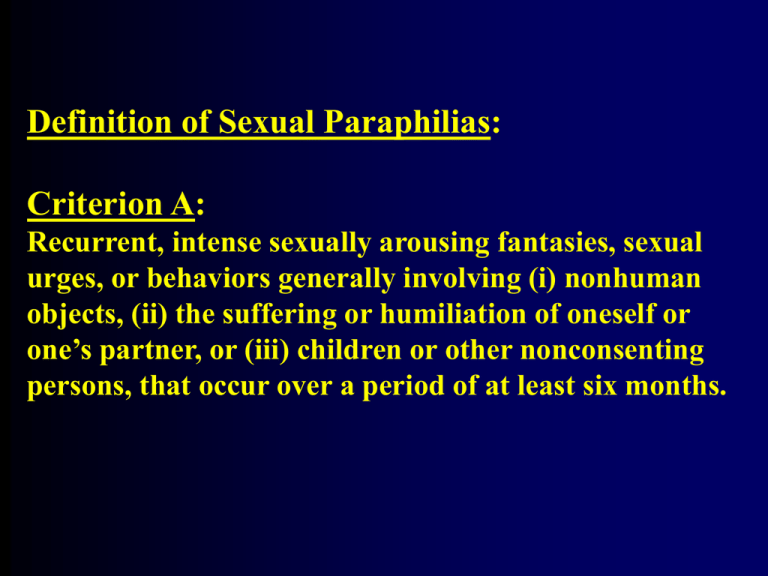
Definition of Sexual Paraphilias:
Criterion A:
Recurrent, intense sexually arousing fantasies, sexual
urges, or behaviors generally involving (i) nonhuman
objects, (ii) the suffering or humiliation of oneself or
one’s partner, or (iii) children or other nonconsenting
persons, that occur over a period of at least six months.
Criterion B:
For some individuals, paraphiliac fantasies or
stimuli are obligatory for erotic arousal and are
always included in sexual activity. In other cases,
the paraphiliac preferences occur only episodically
(e.g., perhaps during periods of stress), whereas
at other times the person is able to function sexually
without paraphiliac fantasies or stimuli. The behaviour,
sexual urges, or fantasies cause clinically significant
distress or impairment in social, occupational, or
other important areas of functioning.
Some Major Categories of Sexual Paraphilia
As Outlined in the DSM-IV:
(1) Exhibitionism: Sexual arousal in response to
exposure of one’s genitals to a stranger
(2) Fetishism: Use of nonliving objects for sexual
arousal
(3) Frotteurism: sexual arousal in response to touching
and rubbing against a nonconsenting person)
(4) Pedophilia: sexual arousal in response to
prepubescent children
(5) Sexual Masochism: sexual arousal in response to
receiving humiliation or suffering
(6) Sexual Sadism: sexual arousal in response to
inflicting humiliation and suffering
(7) Transvestic Fetishism: sexual arousal in response to
“cross-dressing”
(8) Voyeurism: sexual arousal in response to observing
sexual activity
- An additional category, “Paraphilia Not Otherwise
Specified” includes paraphilias that are less frequently
manifested.
- Examples include, but are not limited to:
Non-human objects:
- Zoophilia/Bestiality (animals)
- Urophilia: (urine)
Suffering or humiliation of one’s self or one’s partner:
- Saliromania (Soiling/damaging clothing or body
Children or other nonconsenting partners:
- Necrophilia: (corpses)
Atypical focus involving human objects (self and other):
- Apotemnophilia (Self-amputation)
- Autogynephilia (Image of self as a woman)
- Partialism (Focus on part of the body)
Diagnostic and Statistical Manual of Mental Disorders
(DSM-IV)
American Psychiatric Association
Definition of a Mental Disorder:
(1) In DSM-IV, each of the mental disorders is
conceptualized as a clinically significant behavioral, or
psychological syndrome or pattern that occurs in an
individual and that is associated with present distress
(e.g., a painful symptom) or disability (i.e, impairment
in one or more important areas of functioning) or
with a significantly increased risk of suffering death,
pain, disability, or an important loss of freedom.
(2) In addition, this syndrome or pattern must not be
merely an expectable or culturally sanctioned response
to a particular event, for example, the death of a loved
one.
(3) Whatever its original cause, it must currently be
considered a manifestation of a behavioral,
psychological, or biological dysfunction in the
individual.
(4) Neither deviant behavior (e.g., political, religious,
or sexual) nor conflicts that are primarily between the
individual and society are mental disorders unless the
deviance or conflict is a symptom of a dysfunction in
the individual, as described above.



